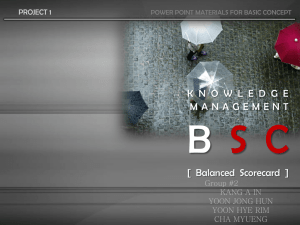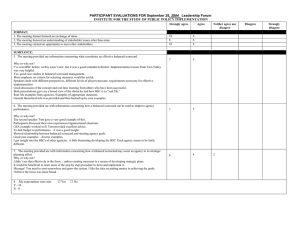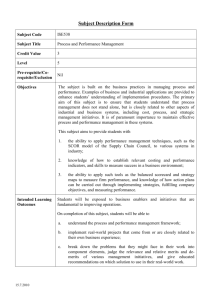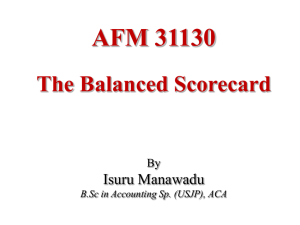By Team B2
advertisement
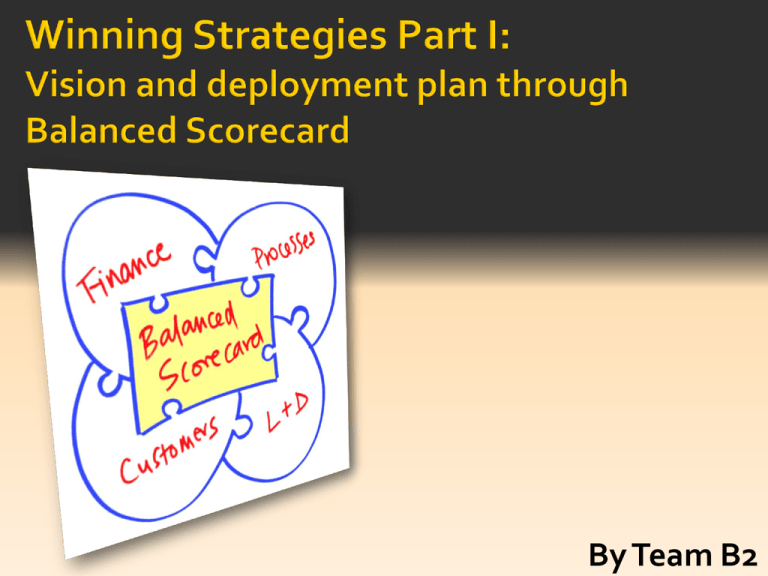
By Team B2 Balanced Scorecard Overview Advantages Disadvantages & how to overcome them Comparison to MBO & BPR Deployment Timeline Four perspective Conclusion Q&A “BSC is a set of measures that gives top management a fast but comprehensive view of the business” (Kaplan & Norton 1992) Illustrate the links between today’s actions and tomorrow’s goals (Kaplan & Norton 1996) 4 Perspectives – Financial, Internal business, innovation & Learning, and Customers Created to tackle the overreliance on financial performance indicators Financial Business Customer Goals Internal Business Learning (Norreklit et al 2008) Kaplan & Norton 1992 Comprehensive & balanced view Framework - what to be done and measured Links between measurements & cause-andeffect relationships to business strategy Corporate vision & strategy meaningful measures for both manages and employees Long term approach Implementation – complicated: BSC top management tool; learning hindered (Johanson et al 2006) Partial implementation – selective and shorten time requirement Treat BSC as a broad learning approach and not mechanically Management isolation (Norreklit et al 2008) Managers need to be familiar with business operations Oversimplification Careful study of circumstances and modify accordingly Time lagging – different perspective require different time scales Set a time-frame/ timeline Measurement prone to manipulation Clearly define measuring process Emphasis on the ‘learning approach’ as opposed to promoting/ firing appraisal Advantages BSC Clear goals & Measurements with links to strategy Comprehensive & Balanced View Long-term structured approach MBO BPR Managers & employees collaborative goals defining (including time-frame best way to obtain goals to improve performance Less time consuming Clear framework to measure organizational performance Systematic approach Innovation orientated – improved productivity Disadvantages Management isolation Time consuming Complex Manipulation Open-ended system too much focus on easily quantifiable financial; overlooking other equally important measures Short-term looking Less comprehensive/ imbalanced Lack of shared vision and goals Lack of interaction within workforce Focus on short term financial criteria Goals Measures Reduce Production Output per hour Cost of sales Develop Sale strategy Gross Profit Margin Operating Profit Margin Cash flow Goals Measures Identify new group of customers Inventory Turnover Identify specification for new groups QFD Survey and Questionnaire Results Goals Measures Develop sale strategy Gross Margin Operating Profit Margin Invest £160k on marketing Balance sheet (Intangible assets ) Rearrange internal production operation and number of employee Employee Turnover Administration Costs Goals Measures Invest in new technology ROA, ROE number of patents Identify enhancements QFD Increase military sales team Gross Profit Turnover Year 1 Year 2 Year 3 Year 4 Year 5 •Increase rescue/military sales team by one person and make two production operatives redundant •Review the SeaSpray and Seahorse markets and target other groups of potential customer in order to develop sales strategy •Spend 15 000GBP on media to better position our products publicly – TV ads, campaigns, attend exhibitions. •Identify enhancements for customer requirements and their costs – invest 45 000 GBP on technology •Continue new user groups identification •Invest 55 000 GBP on marketing •Evaluate customer feedback on the recently implemented technology •Further identify new enhancements – invest 60 000 GBP on technology •Review sales strategy and evaluate against sales trend •Invest further 37 000 GBP on marketing •Review sales strategy •Invest further 35 500 GBP on marketing •Invest 22 500 GBP on Technology – in reference to customer feedback on past enhancements •Invest 17 500 GBP on marketing, increase intensity in successful groups •Invest 22 500 GBP on Technology – in reference to customer feedback on past enhancements •Evaluate business strategy – assess success and rooms for improvements Similarly to other approaches, it has pro’s and con’s. However, for WaveRider’s case, BSC is most suitable as it not only does it provide a comprehensive view of the business, but it also focuses on measures other than financial, which in turn, translate to sustainable long term improvement strategy. Alstyne, M., Brynjolfsson, E., Renshaw, A. (1997). The matrix of change: a tool for BPR. Cambridge: MIT sloan school of management. Dinesh, D., Palmer, E. (1998). Management by objectives and the balanced scorecard: will rome fall again?.Management decision, 36(6), 363-369. Gupta, V., Rohe, D. (1997). Houston business process re-engineering share group: a case study. Business process management journal, 3(2), 173. Johanson, U., Skoog, M., Backlund, A., Almqvist, R. (2006). Balancing dilemmas of balanced scorecard. Accounting, auditing & accountability journal, 19(6), 842-857. Kaplan, R. S., Norton, D. P. (1992). The balanced scorecard- measures that drive performance. Harvard business review, 83(7/8), 172-180. Kaplan, R. S., Norton, D. P. (2001). Transforming the balanced scorecard from performance measurement to strategic management part 1. Accounting horizons. 15(1), 87-104. Larsen, M., Myers, M. (1997). BPR success or failure? a business process reengineering project in the financial services industry. Auckland: association for information system. Norceklit, H., Jacobsen, M., Mitchell, F. (2008). Pitfalls in using the balanced scorecard. The journal of corporate accounting and finance. 19(6), 65-68. Norton, D. P., Kaplan, R. S. (1996, January-February). Using the balanced scorecard as a strategic management system. Harvard business review, 75-85. Pereira, R. (2011). Why HoshinKanri?. Retrieved from http://lssacademy.com/2011/01/03/whyhoshin-kanri/ Rodgers, R., Hunter, J. E. (1991). Impact of management by objectives on organisational productivity. Journal of applied psychology monograph, 76(2), 322-336. Zairi, M., Al-mashari, M. (1999). BPR implementation process: an analysis of key success and failure factors. Business process management journal, 5(1), 87.



